As you travel west from Opelousas (birthplace of zydeco music) on highway 190, you’ll find yourself driving beside rice paddies — Cajun Country is known for its swamps, and rice cultivation is the natural solution to making swampland productive. If you’re taveling the highway between October and May, you may see some curious boats on the water — flat bottomed aluminum boats, each fitted with a large aluminum paddlewheel that bites into the mud and pushes the craft forward. These are the crawfish farmers at their work, harvesting one the area’s most notable delicacies.
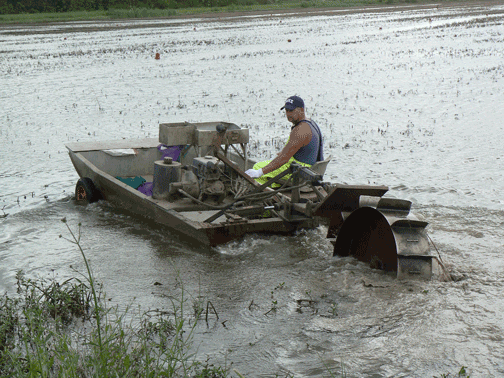
Crawfish farmer Chad Wiltz invited us to tag along
We stopped to talk with crawfisherman Chad Wiltz, who invited us to tag along. Chad makes his living harvesting these small crustaceans on 80 acres of rice ponds, taking about a ton of crawfish per acre annually. I wanted to call this article Crawdaddies in Rice Paddies (it has a nice ring), but we were told they’re called crawfish in Louisiana — crawdaddies are apparently a Texas term).

Crawfish farmer Chad Wiltz
Rice ponds and crawfish form a perfect little sustainable eco-system that results in a pleasant dining experience for the epicurean traveler. Chad sets his wire traps (not unlike lobster traps) in the cooler months when the crawfish come to the surface. As summer comes on in June and the temperature goes up, the crawfish burrow deep into the mud where it’s cooler. Then it’s rice season. When rice season is over in the fall and it starts to cool off, the crawfish come up to the surface to feed on the remains of rice stalks. “A crawfish,” says Chad, “has a short, nasty life.” They’re eaten by bullfrogs, turtles, and the human residents of Louisiana. Harvesting these mud-bugs is a hard way to make a living these days. “The cost of crawfish has gone down since they’re imported from China now,” explained Chad. He sells his catch for about a dollar a pound.
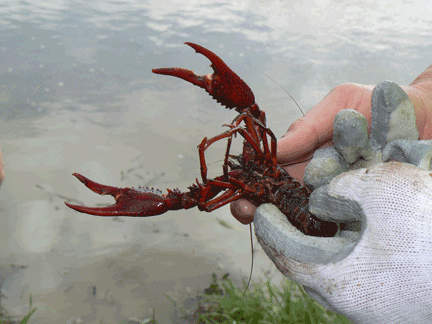
Chad Wiltz wears gloves to protect his hands from crawfish claws
Restaurants in the area, such as Randol’s in nearby Lafayette, serve the critters in five-pound tubs, or with rice and roux in crawfish étoufée. It’s as much a part of the culture as music and dancing, which you can also enjoy at Randol’s.
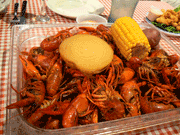
Crawfish with cornbread and corn-on-the-cob at Randol’s
Like the rest of North America Cajun Country is a melting pot, but it’s a little more insular owing to its swamps and bayous, and the local patois which stems from French (though with it’s own peculiar quirks of pronunciation). Cajuns are the descendents of French colonists who originally settled Acadia (now Nova Scotia) in 1605. After being expelled from Canada by the British in 1755, many came down the Mississippi to settle in the area that now falls within the borders of Louisiana and southern Mississippi. The term “Acadian” evolved into Cajun the same way Indian became Injun. French remained the primary language here until the U.S. banned speaking French in schools in the early 20th century. Even so, today more than 40% speak the local dialect as a second language.
Cajun Country’s isolation came to an end after World War II with the building of new roads and economic expansion brought on in good measure by a burgeoning oil industry. Cajun descendants today number less than 50% of the local population, but they account for the major influence of culture, as newcomers find the food, the music and the laissez le bon temps roulez attitude infectious.
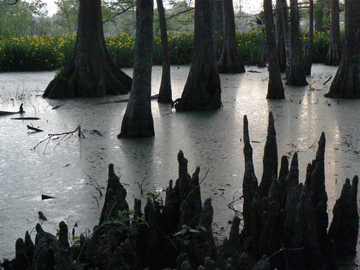
Dark trees in the bayous
Despite their historic isolation, Cajuns have always lived side-by-side with Native Americans and Creole’s (those of French, Spanish and West Indian descent whose culture is based in New Orleans). The cultures don’t so much clash, as blend. As such, you’ll find Louisiana restaurants serving Cajun crawfish étoufée and Creole shrimp gumbo, and Jambalaya that can swing both ways, but the dishes made in the country may be subtly different than the same dishes you find in Baton Rouge or New Orleans. It’s a complex issue and you’ll get a different answer to the question depending on who’s talking.
To learn more about Cajun and Creole culture and cuisine, you can do no better than to visit Vermilionville, the Cajun/Creole Heritage & Folklife Park in Lafayette, bordering Bayou Vermilion across the street from the Lafayette Regional Airport. It’s the Williamsburg of Louisiana.
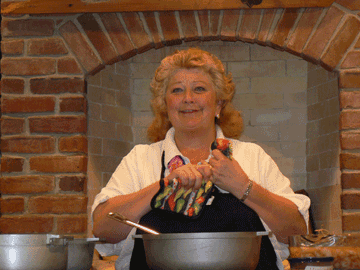
Mama Redell teaches Creole / Cajun cooking at Vermilionville, the Cajun/Creole Heritage & Folklife Park in Lafayette
Lafayette began life as Vermilionville, changing its name in 1844 in honor of the French Marquis de Lafayette. There are 19 buildings on 23 acres at Vermilionville, reflecting the homes and farms of the area between 1765 and 1890. Docents in period clothing will explain what crops were grown, how the farms were worked, how crafts were made. You can experience the local food in the restaurant, or a cooking demonstration from Mama Redell, followed by lunch. Mama Redell showed us how to make Creole Shrimp and Okra Gumbo,Cajun Crawfish Etoufée and Corn Macque Choux, passing on many small tips you’re not likely to find in a cookbook, such as how to keep okra from becoming slimey by adding a dash of vinegar, or the proper use of Filé powder, and where to find the best mail-order Cajun meats and spices.
While Vermilionville can give you a sense of the history of the cuisine, restaurants in Lafayette will give you the modern interpretation of what makes a dish Cajun or Creole. Since culture is ever-changing, understanding the cuisine is as slippery as handling an eel. A case in point is the aforementioned Randol’s, owned by Frank Beaulieu Randol, who has a second home on Maui. He’s also traveled the Pacific Rim and those influences inform his cuisine.
 Randal’s neon Tabasco sign |
 Frank Beaulieu Randol |
A little more formal (business casual) is Charley G’s Seafood Grill, where chef Holly Goetting hold’s court. There is nothing rustic about this food, even if traditional crawfish, tasso and andouille sausage are used in the recipes. You’ll also find coconut shrimp, and shrimp Meador (pecan crusted shrimp with herb saint, bacon creamed spinach and provolone cheese).
And of course in any city if you’re looking for good food and good value you look to where the locals eat. In old downtown Lafayette that would be Don’s Seafood & Steakhouse, which opened its doors in 1934. There we ran into dentist Dick DeJean, who has been coming to Don’s Seafood since he was 6 (let’s say for about 55 years). “The Landrys and Moutons have been coming here since that time too. They make the best Remoulade sauce here, that you have on your grilled shrimp? This was the center of the town. The town grew out from here.” Don’s is also known for it’s crawfish bisque.
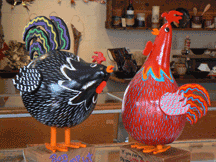
Carol Thibodeaux’s whimsical rooster gourds can be found at Sans Souci in Lafayette
Lafayette (which is pronounced Laugh-ee-et by the locals) is the biggest town in the center of Cajun culture, with 110,000 permanent inhabitants and the seasonal student body of the University of Louisiana at Lafayette. Worthy of a visit is St. John’s Cathedral, its 500-year-old oak tree, and the cemetery that stretches back to the early 19th century. If you’re into arts andcrafts, you’ll want to visit Sans Souci, the gallery for an art guild comprised of 200 artists. It’s housed in an historic building, displaying over 4,700 items of sculpture, paintings, jewelry, textiles, glass, folk art and furniture. My favorites were Carol Thibodeaux’s whimsical gourd roosters.
To the north you’ll find the charming town of Opelousas, of interest to foodies because it’s the home of Tony Chachere’s (pronounced Sash-ah-ree’s) Creole Foods and Targil Seasoning, where you can pick up the local spice blends, as well as the J.B. Sandoz Hardware Store, owned by the Sandoz family since 1878, where you’ll find all manner of culinary equipment (or a hammer if you need it).
The Palace Café in Opelousas, owned and operated by the same family for 75 years, is included on the Prairie Home Cooking loop of the recently designated Louisiana Culinary Trails (http://www.louisianatravel.com/eat/culinary/). In an effort to entice tourists to visit the state, the Louisiana tourist commission has come up with a guide highlighting 7 different culinary trails pointing out notable restaurants along the way. The guide is not exhaustive, but it does give the uninitiated a framework in which to explore Louisiana’s culinary breadth. But there are so many thousands of restaurants in the state it can’t do more than scratch the surface. For instance, if you’re following the Praire Home Cooking loop, the map omits the town of Washington altogether.
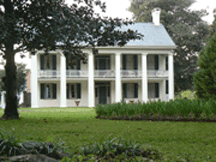
A plantation house in Washington, Louisiana
Washington, with a population of just over 1,000, is a few miles above Opelousas on highway 49. Fully 80% of the buildings in Washington are on the National Historic Register. They range from plantation mansions to storefronts to small homes, and many have been turned into charming bed-and-breakfasts. This is the place to settle down, listen to the birds and experience the pace of another age. Whether spending the night or just passing through, it’s advisable to obey the speed limits, as the town is a notorious speed trap. If you linger, you may enjoy the many antique shops, or arrange for a hayride tour guided by Mr. Raynold Soileau, who has lived here all his life and recounts the stories and history of the town with obvious affection.
However, the epicurean traveler will make this a destination because Washington is the home of Steamboat Warehouse Restaurant. As the name implies, the restaurant is housed in a warehouse that was built in the 1820s when Washington was the largest inland port between New Orleans and St. Louis. Though the coming of the railroad killed the river trade, and the last steamboat pulled out in 1911, today you can dine on the edge of Bayou Cortableau, where young Chef Jason Huguet quietly turns out such mind boggling dishes as deep fried eggplant mounded with lump crab in a cream sauce, jalapeño poppers with crawfish, frog legs, luscious bread pudding and the best pecan pie I’ve ever had. In a big city, in a fancy restaurant, this chef’s food would earn him a monster reputation. Instead, he’s out here on the bayou in a rustic warehouse. Steamboat Warehouse should be on your must-eat-there list.
Where to Eat in Cajun Country
